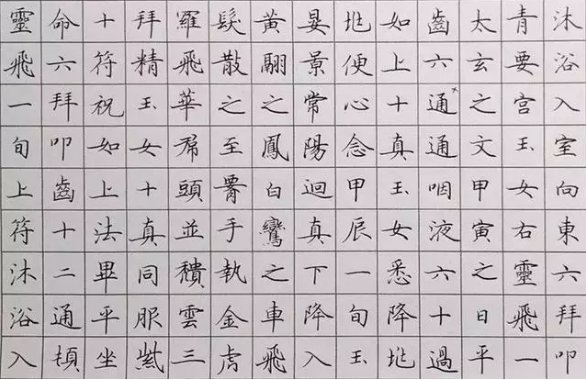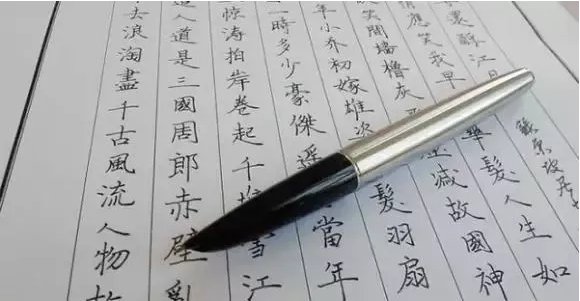The biggest feature of pen calligraphy is practicality. Practicality is the most basic value of a font. The more widely used a font is in real life, the higher its practical value. Whether in China or around the world, you can see people writing with pens everywhere, and they all want to write well. This is almost a sign of social civilization. In fact, writing well can indeed improve work efficiency, reduce errors, and improve achievements. So, how should primary school students write pen calligraphy well?

1. You must have correct posture when practicing calligraphy
People who have wrong writing posture often don't feel that their posture is wrong. However, when others looked at his handwriting, they knew it was "crooked."
Posture has a great influence on words. Some people write like "wind blowing", all falling in one direction; some people write like "climbing a slope" with the left side low and the right side high. This is all caused by incorrect posture. Over time, not only will the handwriting not be good, but the body will also develop deformities. The correct posture is as follows:
Writing pen calligraphy with your head is different from calligraphy with calligraphy. It does not need to be straight, and you can tilt your head slightly to the left. Because the Gangbi characters are held obliquely, leaning slightly to the left makes it easier to see the movement of the pen tip and process the structure of the font. When writing ordinary characters, keep your eyes about one foot away from the tip of the pen so that you can observe and adjust the relationship between a character and the characters above, below, left and right. The distance between the eyes and the pen tip also needs to be adjusted according to the size of the characters. Generally speaking, when writing regular characters and small characters, they should be closer, while when writing cursive characters and large characters, they should be further away.
The body and buttocks are generally sitting flat on one side of the chair slightly closer to the table, with the back straight and leaning slightly forward.
The chest should be relaxed, keep breathing freely, and there should be a fist distance from the edge of the table.
The arms and shoulders should be relaxed, the upper arm is naturally supported on the table, the forearm is flat, and the hands are coordinated, pressing the paper with the left hand and holding the pen with the right hand. The edge of the paper is slightly tilted to the left at a fifteen-degree angle with the desktop, but this should not affect the movement of the body's center of gravity.
After practicing calligraphy, you can write quickly on horseback, boat or carriage, and you don’t have to pay attention to any posture. But during the practice stage, especially in elementary school, good habits must be developed. Only with this foundation can we write well under adverse circumstances.
2. When practicing calligraphy, you must have the correct method of holding and operating the pen.
It seems that everyone knows how to use a pen, but if you want to practice calligraphy well, there are some details that you should pay attention to.
Generally speaking, now it is the "three-finger writing method". That is to say, "the thumb and index finger pinch the penholder tightly, and the upper part of the penholder naturally leans against the tiger's mouth of the palm. In fact, these three fingers alone are not enough. The index finger and the little finger also play a very important role. Importantly, they are bent into rows and attached to the paper to ensure the stability of writing for long distances.
When writing with a fountain pen, we should pay attention to "the finger is strong and the palm is empty". The so-called "solid" means that the finger holding the pen must be pressed hard on the fingertip, especially the left side of the upper end of the middle finger nail, which is the most difficult. When writing for a long time, a small pit will be pressed here, or even a callus will be formed. If you don't use force here, you won't be able to hold the pen firmly and you won't be able to move the pen vigorously. The so-called "empty" means that the center of the palm should be naturally empty, and it also means that the ring finger and little finger that are used as supports should not be pressed tightly on the table. They should be lifted "empty" to make the writing flexible.
Regarding the operation of the pen, first use your fingers to move the pen barrel. The pen tip has a small range of movement and does not change much in ups and downs. Secondly, the range of movement of the "suspended wrist" nib has been expanded, and the changes in ups and downs are also rich. However, the disadvantage of the latter is that writing small characters with large movements is unstable. In order to preserve the length of the "hanging wrist" and make up for the shortcomings of instability, you can mobilize the little finger to play a supporting and adjusting role. When writing in this way, the wrist and the tabletop are close to each other. When they are separated, the little finger is slightly used as a fulcrum to make the pen movement stable; when they meet, the little finger is slightly supported to make the pen movement flexible.
3. Pay attention to the pen writing style
When it comes to using a pen, the ancients also called it "pen technique". Some people say that pen calligraphy only focuses on structure and not on brushwork. In fact, they ignore an important aspect of writing good pen calligraphy. How can pen calligraphy not pay attention to brushwork? It's just more subtle than the changes in calligraphy.
We primary school students usually write rutting books, so the way the pen is used cannot copy the "reversal" of the calligraphy brush. But we still need to understand the spirit of "nothing hangs, no shrinking, nothing goes in", that is to say, we must use changes in weight, speed, hardness and softness to achieve the purpose of being calm and powerful. In one word, we must learn to use both light and heavy, hard and soft. In summary, we need to pay attention to the two words "catch" and "press". In this way, although the pen calligraphy is small, it still has a contrast between calmness and flying, thick and fine, masculine and feminine; between dots and dashes, it is not a simple combination of uniform lines like thin iron wires, but a rhythm and charm. , dynamic. then. It is possible to show beauty in the appropriate shelf structure.
4. The structure of the characters should be repeatedly studied.
Whether a word is good-looking or not depends on the writing technique. The first step is to talk about the frame structure.
"Frame structure", these four words are borrowed from the words of building a house. Isn’t the word “facade”? To repair a facade, you first need to build a frame with seven beams and eight columns, which is called a "frame". After the shelf is set up, some interconnecting parts must be added between the beams and columns, and doors and windows must be installed. These are collectively called "structure". The "frame structure" of a character includes the overall combination of various radicals and other parts, as well as the specific combination of strokes.
5. To write well, the order of strokes cannot be ignored.
Primary school students often have a problem with writing, which is called "inserting the pen", that is, the wrong "stroke order" has a lot of harm. The first is the frame structure layout that affects the whole character. For example, for the word "王", it would be awkward to write the "一" below first, and then write it upwards, and the balance of the whole character would be difficult to grasp. The second is the impact on writing speed. There are rules in the composition of Chinese characters. If you violate these rules and struggle to write, you will certainly not be able to write quickly. For example, when writing "person", you must write it out first and then write it down. If you write it out first and then write it down, it will obviously go in a circle and it will take a lot of time.

The responsibilities of stroke order can be roughly summarized into the following points;
1. No matter how many parts a word consists of, the upper part must be written first, and then the lower part.
2. First left and then right
3. First there is a vertical tick in the middle, then on the left and right, and on the left and right are the words for dots and dots. Write the middle part first, and then write the two dots from left to right.
4. First left, right and then middle
5. There are relatively few characters such as "女", "Mother", "无", etc. You have to wait for the basic framework of the characters to be completed before you can write the "Baiwan" stroke.
6. Finally, form four frames around the seal. Write on the left, top and right first, then write on the inside, and finally seal.
In addition to the above six basic rules, there are also some special situations. For example, for the lower half of the character "square", the stroke order should be from right to left. Another example is the character "you", which is similar to the third category above. You should also write the middle first, then left and right. But this kind of situation is rarely taught. When you encounter it occasionally, just remember it specially.
These six basic rules are not isolated. They are often used comprehensively in one word, both from top to bottom and from left to right.
So don't memorize these rules, but master the stroke order of each word through actual practice.
How do primary school students practice pen calligraphy well? I believe everyone understands this issue: Only by bold practice under the guidance of correct theory can we achieve the ideal state.








